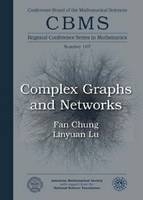
Complex Graphs and Networks
Seiten
2006
American Mathematical Society (Verlag)
9780821836576 (ISBN)
American Mathematical Society (Verlag)
9780821836576 (ISBN)
- Titel z.Zt. nicht lieferbar
- Versandkostenfrei
- Auch auf Rechnung
- Artikel merken
Based on lectures given at the CBMS Workshop on the Combinatorics of Large Sparse Graphs, this work presents fresh perspectives in graph theory and helps to contribute to a sound scientific foundation for our understanding of discrete networks that permeate the information age.
Through examples of large complex graphs in realistic networks, research in graph theory has been forging ahead into exciting new directions. Graph theory has emerged as a primary tool for detecting numerous hidden structures in various information networks, including Internet graphs, social networks, biological networks, or, more generally, any graph representing relations in massive data sets. How will we explain from first principles the universal and ubiquitous coherence in the structure of these realistic but complex networks? In order to analyze these large sparse graphs, we use combinatorial, probabilistic, and spectral methods, as well as new and improved tools to analyze these networks. The examples of these networks have led us to focus on new, general, and powerful ways to look at graph theory.The book, based on lectures given at the CBMS Workshop on the Combinatorics of Large Sparse Graphs, presents new perspectives in graph theory and helps to contribute to a sound scientific foundation for our understanding of discrete networks that permeate this information age.
Through examples of large complex graphs in realistic networks, research in graph theory has been forging ahead into exciting new directions. Graph theory has emerged as a primary tool for detecting numerous hidden structures in various information networks, including Internet graphs, social networks, biological networks, or, more generally, any graph representing relations in massive data sets. How will we explain from first principles the universal and ubiquitous coherence in the structure of these realistic but complex networks? In order to analyze these large sparse graphs, we use combinatorial, probabilistic, and spectral methods, as well as new and improved tools to analyze these networks. The examples of these networks have led us to focus on new, general, and powerful ways to look at graph theory.The book, based on lectures given at the CBMS Workshop on the Combinatorics of Large Sparse Graphs, presents new perspectives in graph theory and helps to contribute to a sound scientific foundation for our understanding of discrete networks that permeate this information age.
Graph theory in the information age Old and new concentration inequalities A generative model--the preferential attachment scheme Duplication models for biological networks Random graphs with given expected degrees The rise of the giant component Average distance and the diameter Eigenvalues of the adjacency matrix of $G(/mathbf{w})$ The semi-circle law for $G(/mathbf{w})$ Coupling on-line and off-line analyses of random graphs The configuration model for power law graphs The small world phenomenon in hybrid graphs Bibliography Index.
| Erscheint lt. Verlag | 30.8.2006 |
|---|---|
| Reihe/Serie | CBMS Regional Conference Series in Mathematics |
| Zusatzinfo | Illustrations |
| Verlagsort | Providence |
| Sprache | englisch |
| Maße | 177 x 251 mm |
| Gewicht | 680 g |
| Themenwelt | Mathematik / Informatik ► Informatik ► Theorie / Studium |
| Mathematik / Informatik ► Mathematik ► Graphentheorie | |
| Mathematik / Informatik ► Mathematik ► Wahrscheinlichkeit / Kombinatorik | |
| ISBN-13 | 9780821836576 / 9780821836576 |
| Zustand | Neuware |
| Informationen gemäß Produktsicherheitsverordnung (GPSR) | |
| Haben Sie eine Frage zum Produkt? |
Mehr entdecken
aus dem Bereich
aus dem Bereich
was jeder über Informatik wissen sollte
Buch | Softcover (2024)
Springer Vieweg (Verlag)
CHF 53,15
Grundlagen – Anwendungen – Perspektiven
Buch | Softcover (2022)
Springer Vieweg (Verlag)
CHF 53,15
Teil 2 der gestreckten Abschlussprüfung Fachinformatiker/-in …
Buch | Softcover (2025)
Europa-Lehrmittel (Verlag)
CHF 37,90


